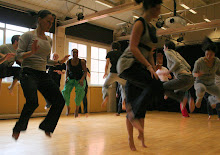1.
‘Physical Theatre’ tells stories through the body rather than necessarily through text. ‘A critical dimension of understanding the emergence of physical theatre practices is to locate them historically within the devising paradigm and its politics of process’ (Murray and Keefe: 2007, p.18) http://books.google.co.uk/books?id=MbOsCnifyaoC&pg=PA4&dq=physical+theatres:+a+critical+introduction#PPA18,M1
Process and Performance has explored physical theatre at its finest. We are currently undertaking journeys on the path to discover physical theatre within our own bodies. One of the key features of physical theatre is expression through the body. The process we are involved in now tells a story through movement. It has enabled us to explore different ideas and relationships using the bodies, and learn about ourselves.
Process and Performance gives us the ability to be part of a devised creative process and explore dance theatre as well. We have learned many physical skills to be able to be part of a physical performance, ‘building our palette’ the whole time. These have ranged from using pedestrian movements effectively; simply telling stories with our bodies, and then completely abstract movements. These equally tell a story, as we have been exploring. We are currently working towards devising a performance, involving all the things we have learned.
2.
The definition of ‘hybrid’ is a cross or mixture. Ana Sanchez-Colberg implies that a ‘new genre’ (Sanchez-Colberg in Keefe & Murray: 2007 p.21) has been created from mixing theatre and dance together. She suggests that to even begin to break down the definition of physical theatre, you must take into consideration the influences of avant-garde theatre and dance. ‘What is physical theatre?’ will always be a question people ask, because it has never been properly defined. People will always disagree on whether it should be a class of its own, or what category it falls under. Dymphna Callery writes, “…it was the dance company DV8 Physical Theatre, which first used the term…” (Callery: 2007 p.6) suggesting that the line is very thin and that companies combine both ideas in their practice. For me, physical theatre is a hybrid performance genre because there will always be elements of both evident in many physical theatre performances.
3.
DV8 Physical Theatre company also class themselves as a dance company. Their website claim that
‘The name was chosen as a result of the dissatisfaction felt by Lloyd and the other founder members with what was happening in contemporary dance at the time. They wanted (and still want) to make work that had meaning for them.’ (http://www.dv8.co.uk/faqs/faqs.html 2009)
This shows that they do fall into the remit of ‘physical theatre’ but they also very much about dance, describing their cast as ‘dancers’ rather than actors. However, to watch DV8 they are a physical theatre company. They tell stories through using their bodies and turn every day pedestrian movements into something much more abstract. Their movements resemble dance but are not as aesthetically pleasing as dance aims to be, even though they aim to take risks, ‘aesthetically and physically…’ As mentioned earlier, physical theatre is about expression through the body and they certainly do this.
Bibliography
Callery, D (2001): Through The Body: New York: Routledge.
DV8 Physical Theatre (2008) [online]. London: [Home Page][cited 24th February 2009]. < http://www.dv8.co.uk/faqs/faqs.html>.
Keefe, J & S Murray (2007) Physical Theatres: A Critical Reader: London: Routledge
skip to main |
skip to sidebar
Welcome to Porto2009.
This is the begining of our journey on the road of Porto2009. And the blog will give us the opportunity as a group to reflect on the work in which we have done within the sessions. We will keep you posted regarding the process we are making along the way.....
Enjoy.
Enjoy.



No comments:
Post a Comment